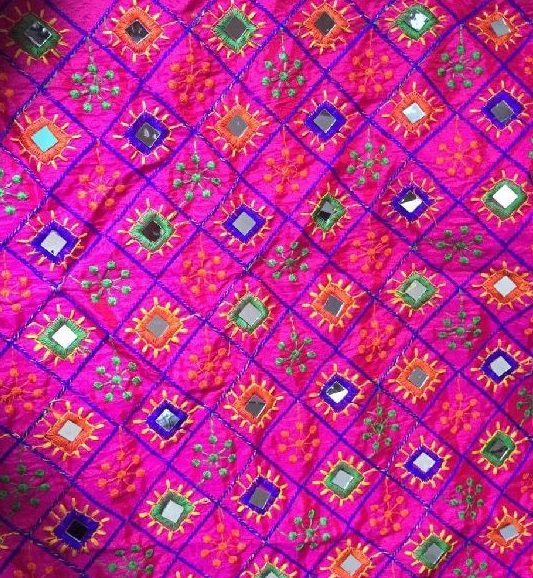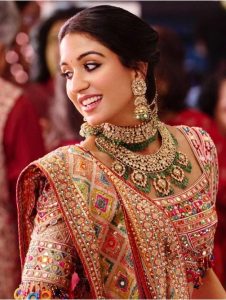SIGN UP FOR NEWSLETTER
Be the First to Know. Sign up to newsletter today

Radhika Merchant’s mirror work bridal lehenga is the talk of the town. It was colourful & captivating.

Mirror work or “Sheesha” is a traditional Indian handicraft in which artisans attach mirrors of different shapes and sizes onto the fabric by special cross-stitch embroidery method. In the villages of Rajasthan, attaching mica to clothes became very popular. Mica was found in abundance in the sand deserts of Rajasthan. Hence, mica was used to embellish mud walls & textiles in the past. This has been replaced with mirrors now.
Jaisalmer, Barmer,Pali & Bikaner are famous for several products made with mirror work in Rajasthan.
With circular one being the popular shape of the mirror of all time, other shapes like square, triangular, hexagonal and polygonal are also otherwise used for embroidery. In addition, when combined with colourful thread embroidery, they are very attractive on clothes and other home decor items. In present day scenario, reflective luminescent metal pieces have replaced mirrors, especially on apparel.
Mirror work is used to enhance sarees, blouses, skirts, chaniya-cholis, bags, bedspreads, cushion covers, wall hangings and many such items. Furthermore, fabrics ranges from georgette to crepe to silk to cotton to chiffon.
Available at Delhi:- Rajasthali, Gurjari(Delhi), Kinari Bazaar
Available at Bangalore:- Yuvathi, Sakhi
Shop in Jaipur at:- Johari Bazar(Jaipur), Riddhi Siddhi Textiles
Available at Mumbai:- Seasons Santacruz, Aishwarya Design Studio, Samrat
With its origins in Iran in the 17th century, the mirror work was first introduced to the Indian culture through different travellers during the Mughal reign. It is interesting to note here that the Mughals never wore clothes beautified with mirrors. As a matter of fact, they used mirror work for decorative purposes only. From decorative items ,this method of embroidery has moved to garments.
The locals soon caught up with the trend, embracing this art form as part of their traditional dresses. The Lambada gypsy tribes of Andhra Pradesh, for example, use mirrors and beads as part of the traditional Banjara embroidery.
Mirrors are fixed on the cloth with cross stitch embroidery that forms a casing around the mirror. The threads for the cross stitch embroidery is colourful and attractive. This is also known in Gujarat as “Abhala Bharat” embroidery .
Rajasthan, Madhya Pradesh, Gujarat and Haryana in India are the major centers for mirror work in India. Each state can be distinguished by its own evolved style of mirror work. To cite an example, the Jats of Banni are known for using variegated mirrors to beautify their fabric. On the other hand, artists fix mirrors on eyes in animal faces or the middle of a flower as part of Gujarat’s Kathi embroidery.

Presently bridal lehengas by top Indian designers use mirrorwork as an important aspect of the design.
Read:
Be the First to Know. Sign up to newsletter today
183 views